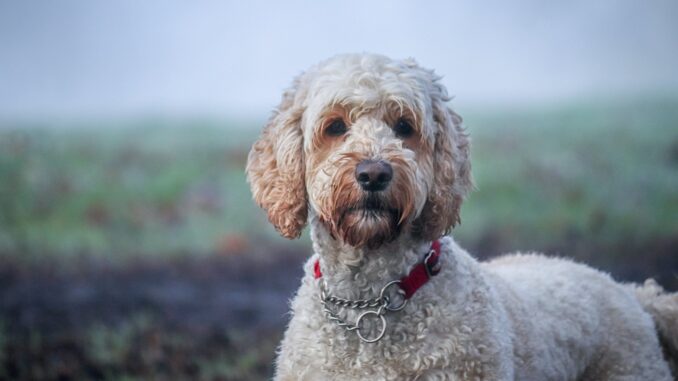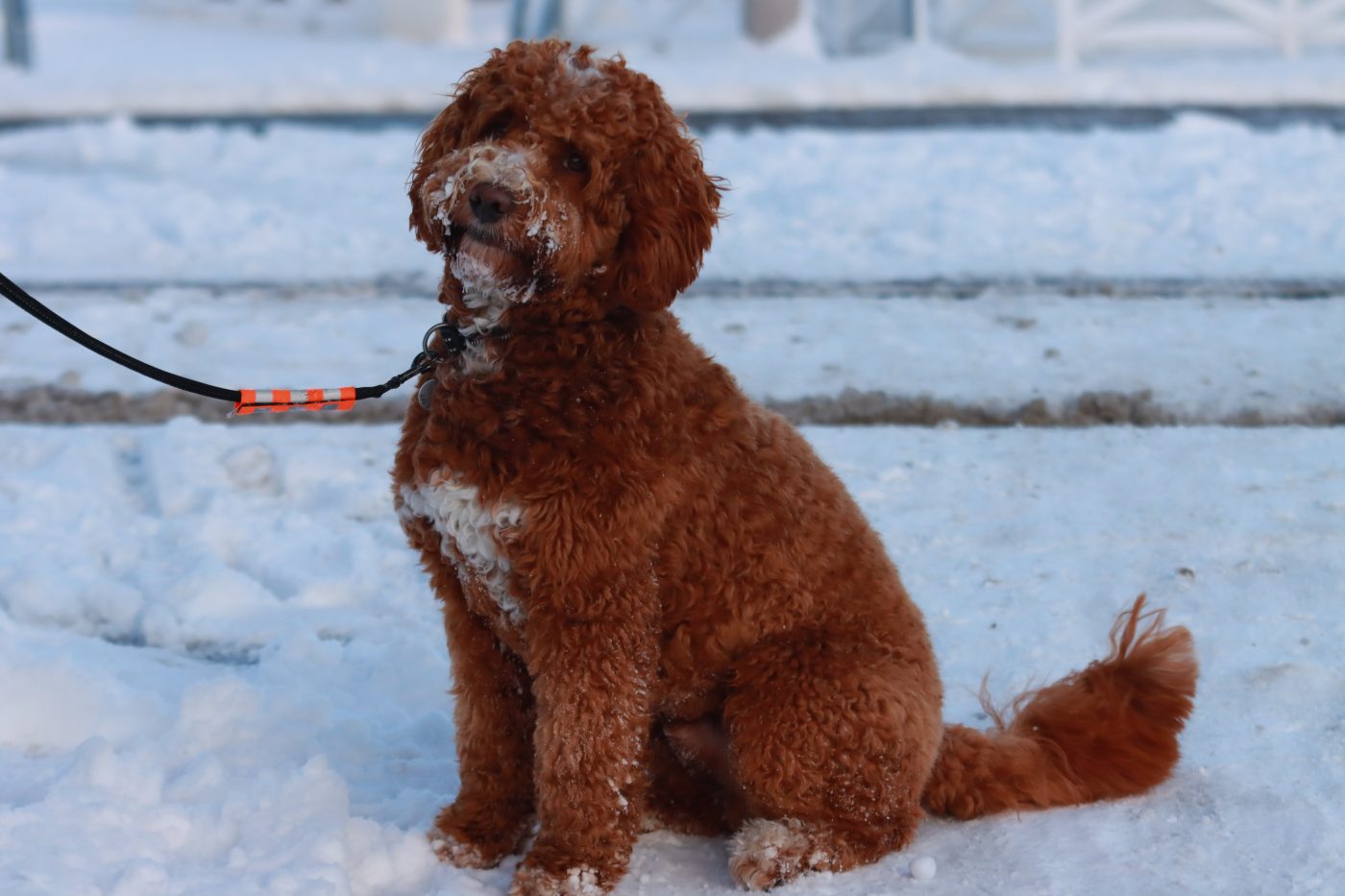
[ad_1]
Labradoodles have rapidly gained popularity for their charming personalities, intelligence, and reduced shedding coats they inherit from their Poodle ancestry. This breed, a cross between a Labrador Retriever and a Poodle, has a variety of coat types ranging from wavy to curly, each with its unique grooming requirements. Proper and regular grooming is essential for maintaining the health and happiness of your Labradoodle. This article will delve into the frequency and methods of grooming this hybrid breed and address their specific grooming needs.
1. Labradoodle Coats
Labradoodles come in three main coat types: wool, fleece, and hair. The wool coat resembles that of a Poodle and is dense with tight curls. The fleece coat is soft with looser curls or waves, and the hair coat is straighter and more similar to that of a Labrador Retriever. Each type requires different grooming strategies to keep the coat in optimal condition.
2. Brushing Frequency and Techniques
Regardless of the coat type, Labradoodles should be brushed several times a week to prevent matting, especially in the wool and fleece types. A slicker brush and a wide-toothed comb are essential tools for working through their dense fur. Brushing not only helps to detangle but also removes dead hair and stimulates the skin, distributing natural oils throughout the coat.
3. Bathing Schedule for Labradoodles
Labradoodles should be bathed every 4-6 weeks. Over-bathing can strip their coat of natural oils, leading to dryness and irritation. Use a gentle, dog-specific shampoo, and ensure that you thoroughly rinse their coat. It’s also crucial to dry their coat completely after bathing to prevent matting.
4. Nail Care: A Vital Aspect
Regular nail trimming is necessary to keep your Labradoodle comfortable and prevent problems with walking and posture. Aim to trim their nails every 4-8 weeks, depending on how quickly they grow and wear down naturally.
5. Ear Care: Preventing Infections
Due to their floppy ears, Labradoodles can be prone to ear infections. Clean their ears regularly with a recommended canine ear cleaner, and be sure to dry their ears thoroughly after swimming or bathing.
6. Dental Hygiene Practices
Like all breeds, Labradoodles require regular dental care. Brush their teeth several times a week to prevent the buildup of plaque and tartar and to keep their breath fresh.
7. Coat Clipping and Trimming
Labradoodles often need a haircut every 8-12 weeks. The “puppy cut” or “teddy bear cut” are popular styles that are manageable and maintain the characteristic look of the breed. Regular trims around the eyes, mouth, and paws are also necessary for cleanliness and comfort.
8. Grooming Tools for Your Labradoodle
Invest in quality grooming tools such as a slicker brush, a wide-toothed comb, grooming clippers, thinning shears, nail clippers, ear cleaner, and canine toothbrush and toothpaste.
9. Handling a Labradoodle’s Sensitive Skin
Some Labradoodles can have sensitive skin. Use hypoallergenic grooming products when necessary and consult a veterinarian if you notice signs of skin irritation or allergies.
10. Professional Grooming Considerations
While regular home grooming is important, professional groomers can be very helpful, particularly for haircuts and when dealing with matting issues.
11. Grooming as a Bonding Time
Grooming sessions are an excellent opportunity to bond with your Labradoodle. They can become a time of relaxation and enjoyment for your dog with the right approach and positive reinforcement.
12. Seasonal Grooming Adjustments
Your Labradoodle’s grooming needs may change with the seasons. They may require more frequent brushing during the shedding seasons and additional paw care during the winter months.
Conclusion
Grooming your Labradoodle is a significant but rewarding responsibility. It’s crucial not only for maintaining their distinctive appearance but also for ensuring their physical well-being. A consistent grooming routine will help prevent mats and tangles, promote skin health, and strengthen the bond between you and your Labradoodle. With dedication to their grooming needs, your Labradoodle will look, feel, and act their best.
Frequently Asked Questions About Grooming A Labradoodle

1. How often should I brush my Labradoodle?
Regular brushing of your Labradoodle is essential to prevent matting and tangling, especially if they have a wool or fleece coat. Aim to brush your dog at least 2-3 times a week with a slicker brush and a comb, increasing to daily during periods of heavy shedding or if they have a particularly thick coat.
2. What type of brush is best for a Labradoodle?
A slicker brush is excellent for daily grooming of your Labradoodle, as it can help work out tangles and mats. For the undercoat, a steel comb or a de-matting rake can be useful, especially for wool and fleece-coated Labradoodles to prevent mats from forming close to the skin.
3. How often should a Labradoodle be bathed?
Labradoodles should be bathed every 4-6 weeks to keep their coat clean and healthy. It’s important to use a mild, dog-specific shampoo and to thoroughly rinse off any product to prevent irritation. Make sure they are completely dry after their bath to avoid any matting.
4. How do I prevent my Labradoodle’s coat from matting?
Preventing matting in your Labradoodle’s coat requires regular brushing and combing to remove dead hair and prevent tangles. Pay special attention to areas prone to matting such as behind the ears, under the belly, and around the rear end. After bathing, ensure the coat is dried and brushed thoroughly to prevent any mats from setting in.
5. How do I trim my Labradoodle’s coat?
Trimming your Labradoodle’s coat can be done at home with the proper tools, like grooming clippers and scissors, focusing on key areas like around the eyes, paws, and sanitary regions. For full haircuts or styling, it’s often best to seek a professional groomer experienced with the breed.
6. How do I clean my Labradoodle’s ears?
To clean your Labradoodle’s ears, gently use a vet-recommended ear-cleaning solution and a cotton ball. Wipe away debris from the outer ear and around the ear canal, but avoid inserting anything deep into the ear to prevent damage.
7. What dental care should be provided for a Labradoodle?
Dental care for a Labradoodle should include brushing their teeth several times a week using dog-specific toothpaste and a soft toothbrush. Regular dental check-ups and cleanings by a veterinarian can also help maintain your dog’s oral hygiene.
8. Can I shave my Labradoodle in the summer to keep them cool?
It is generally not recommended to shave your Labradoodle, even in the summer, as their coat provides protection from the sun and helps regulate their body temperature. Instead, ensure they have plenty of water, and access to shade, and keep them indoors during the hottest part of the day.
9. What should I do if my Labradoodle is anxious during grooming?
If your Labradoodle is anxious during grooming, try to create a calm environment, use positive reinforcement, and be patient. Introduce grooming tools and procedures gradually, and consider consulting with a professional groomer for tips and training techniques to make grooming a more positive experience.
10. How often should my Labradoodle visit a professional groomer?
Professional grooming frequency can depend on your Labradoodle’s coat type and your own grooming capabilities. Generally, a visit every 6-8 weeks can help with more complex grooming needs like haircuts, ear cleaning, and nail trimming, especially if your Labradoodle has a wool or fleece coat that requires more intricate care.
[ad_2]
Source link

Leave a Reply